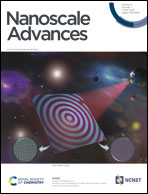Ultra-small-sized multi-element metal oxide nanofibers: an efficient electrocatalyst for hydrogen evolution†
Abstract
Compared to noble metals, transition metal oxides (TMOs) have positive development prospects in the field of electrocatalysis, and the synergy between the elements in multi-element TMO-based materials can improve their catalytic activity. However, it is still a challenge to synthesize multi-component TMO-based catalysts and deeply understand the effects of components on the catalytic performance of the catalysts. Here, we demonstrate multi-element ultra-small-sized nanofibers for efficient hydrogen production. The ternary NiFeCoO nanofiber-based electrode reached an overpotential of 82 mV at the current density of 10 mA cm−2 with a Tafel slope of 56 mV dec−1 in 1 M KOH, which are close to those of Pt plate (66 mV at 10 mA cm−2; the Tafel slope is 32 mV dec−1). In addition, the current density maintained 97% of its initial value after 10 h operation. We used the ternary NiFeCoO nanofiber-based electrode as an efficient counter electrode in photoelectrochemical hydrogen production to demonstrate the versatility of these nanofibers.



 Please wait while we load your content...
Please wait while we load your content...